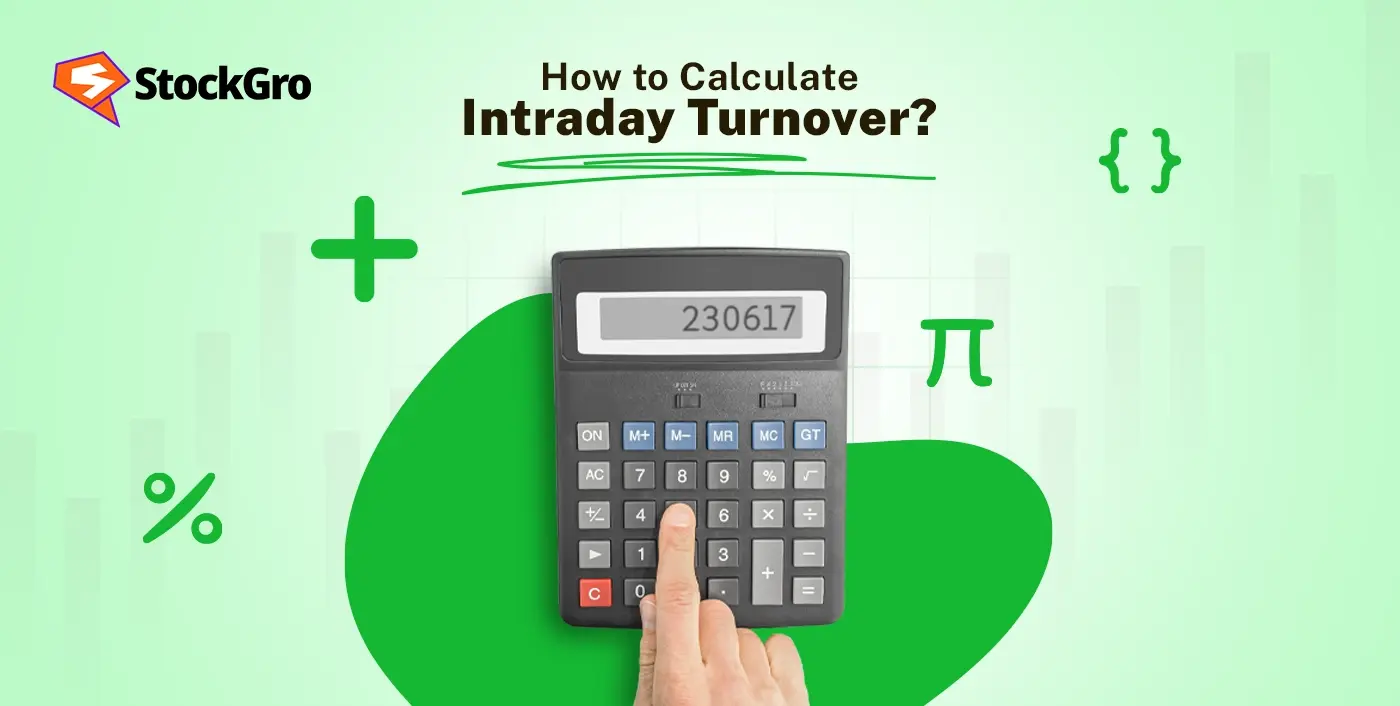
A surge in retail holdings of over ten times was witnessed throughout the past decade. The growing Indian economy and a stronger Indian middle class back this upward trend of retail participation.
Moreover, each new investor enters the market with a unique fiscal goal and temperament. While some aim for controlled long-term growth, others might choose to take advantage of short-term opportunities. An example of the latter kind is the intraday traders.
A SEBI study published on 24 July 2024 noted a 300% rise in intraday trades in the equity cash segment as of FY 2022-23. However, it also highlights that 7 out of 10 such traders have incurred losses.
Therefore, this blog aims to delve into a key metric of intraday trading, called intraday turnover. Understanding how to calculate intraday turnover can aid investors in gauging the possibility of money-making in intraday trade, tax compliance and much more.
How to Calculate Intraday Turnover?
Calculate intraday trading turnover by adding the absolute value of all buy and sell transactions done in a day. Intraday turnover aids in understanding the overall possibility of profitability in intraday trades. By calculating the turnover of intraday trading, investors can compute the absolute sum of profit and loss generated from all intraday trading activities over any period.
For instance, suppose Mr A made a loss of ₹100 in one intraday transaction and a profit of ₹500 from another. Therefore, the overall money-making in intraday expected by Mr A is ₹400. However, the turnover is ₹600 (100 + 500).
Therefore, while turnover does not show profitability, it shows the intensity of trading activity and is necessary for compliance with the prevalent tax laws.
However, the understanding of how to calculate intraday turnover is multifaceted. Let’s explore it in more detail.
- Computing Intraday Turnover
Before getting into a more nuanced look at how to calculate intraday turnover, let us look at the most commonly used formula.
| Turnover = Absolute gain or lossTherefore, Turnover = Total profit from intraday trade + Total loss from intraday trade |
Now, the formula above is derived based on certain parameters. Each of them is discussed below.
- Proceeds: It refers to the amount of money derived from an intraday transaction. It is derived by multiplying the difference between the selling price and the cost price by the quantity of stock transacted. For example, suppose A bought 10 shares for ₹10 and sold them at ₹15.
| Proceeds = (SP – CP) X Number of shares= ₹(15 -10) x 10 = ₹50 |
- Transaction costs: Various costs are related to trading in the form of expenses and taxes. Brokerage charges, platform fees, GST, Securities Transaction Tax, etc., are some examples. These costs must be deducted from the proceeds to find the actual amount of profit or loss.
- Margin charges: When a trader borrows money from their broker to invest in the market, it is called margin trading. Suppose Mr A borrowed ₹5,000 to invest in the stock market at 6% interest. The interest is the cost of margin trading and must be deducted to establish the actual profit or loss.
While the discussion till now might have given the pieces to the puzzle of how to calculate intraday turnover, completion of the puzzle requires a look at an illustration to ensure a complete understanding.
- How to Calculate Intraday Turnover: Example
Mr C bought 1000 shares at ₹150 and sold them at ₹120 in one trading session. In the next session, he sold 800 shares, bought at ₹150, at ₹120. Note that each amount includes the transaction costs.
Now, the table below shows how to calculate intraday turnover.
| Session | Computation (₹) | Profit or Loss (₹) | Absolute Profit or Loss (₹) |
| 1 | (150 – 120) x 1000 | +30,000 | 30,000 |
| 2 | (120 – 150) x 800 | -24,000 | 24,000 |
| Total Turnover (30,000 + 24,000) | 54,000 | ||
Although this is the most commonly used method, it is not the only method of computing intraday trading volume.
Methods of Calculating Intraday Turnover
Understanding how to calculate intraday turnover includes comprehension of two key methods. Let us first understand each of them in detail before getting into a comprehensive comparison of the two.
- Scrip-wise Turnover
In the context of intraday trading turnover, a scrip refers to a particular stock or security. Under the scrip-wise turnover calculation method, investors first aggregate the sum of profits or losses from each scrip, then compute the absolute value.
For instance, suppose Mr A made four trades as shown in the table below.
| Trade | Purchase Price (₹) | Selling Price (₹) | Quantity |
| 1 | 100 | 110 | 10 |
| 2 | 120 | 110 | 20 |
| 3 | 130 | 140 | 20 |
| 4 | 100 | 130 | 5 |
According to this method, first, the aggregate profit or loss is calculated.
| Trade | Computation (₹) | Profit/loss (₹) |
| 1 | (110 – 100) x 10 | +100 |
| 2 | (110 -120) x 20 | -200 |
| 3 | (140 -130) x 20 | +200 |
| 4 | (100 -130) x 5 | -150 |
| Aggregate (100 + 200) – (200 + 150) | – 50 | |
Now, the turnover is the absolute value of the aggregate.
Turnover = |-50| = 50
- Trade-wise Turnover Example
The most common method of calculating turnover in intraday trading, which has already been discussed before in this blog, is the trade-wise turnover. Under this method, the absolute value of proceeds is summed up.
Let us calculate the turnover of Mr A again but through trade-wise turnover.
| Trade | Purchase Price (₹) | Selling Price (₹) | Quantity | Computation (₹) | Profit/Loss | Absolute Profit/Loss |
| 1 | 100 | 110 | 10 | (110 – 100) x 10 | +100 | 100 |
| 2 | 120 | 110 | 20 | (110 -120) x 20 | -200 | 200 |
| 3 | 130 | 140 | 20 | (140 -130) x 20 | +200 | 200 |
| 4 | 100 | 130 | 5 | (100 -130) x 5 | -150 | 150 |
Now, the turnover is the aggregate of all absolute values.
Turnover = ₹ (100 + 200 + 200 + 150) = ₹ 650
Notice how the value of turnover derived through the scrip-wise method is lower than that derived through the trade-wise method. Several key differences contribute to this distinction.
Comparing Trade-wise vs. Scrip-wise
A complete comparison of the two methods of calculating turnover can aid in clarifying the comprehension of how to calculate intraday turnover.
| Particulars | Trade-wise turnover | Scrip-wise turnover |
| Meaning | It aggregates the absolute value of all intraday trades. | It is the absolute value of the aggregate of all intraday trades. |
| Scale | More granular in approach | Simplistic in nature |
| Amount | The turnover amount is higher | The turnover amount is lower |
| Preference | Preferred more for regulatory compliance and audits | Usually used for its simplistic nature. |
Although the computation under both methods is quite straightforward, some mistakes might hamper the results.
Common Mistakes to Avoid
Discussed below are some common mistakes that must be avoided while calculating intraday turnover. Without understanding these roadblocks, the understanding of how to calculate intraday turnover is incomplete.
- Confusing turnover with trading volume: Turnover is the aggregate of absolute profit and loss, whereas trading volume is the number of equity shares or their equivalent monetary value transacted.
- Not understanding the need for intraday turnover: Tax compliance is the primary use case of intraday turnover. Intraday trading is considered a speculative business and is taxed under profits and gains from business or profession. Moreover, whether a tax audit is applicable is dependent on intraday turnover and not actual profit or loss. If the turnover is more than ₹10 crores, a tax audit is applicable.
- Omitting absolute value: Often due to a lack of understanding about the concept and how to calculate intraday turnover, individuals miss taking the absolute values. Both profits and losses are added in absolute terms to calculate turnover.
- Omission of expenses: The costs incurred to execute an intraday trade must be adjusted with the proceeds to generate the actual returns. The omission of these values leads to an overestimation of proceeds.
Key Takeaway from How to Calculate Intraday Turnover
Intraday turnover is an important aspect of intraday trade necessary for regulatory compliance. It refers to the process of computing the absolute aggregate profit and loss incurred during intraday trades over a particular tenure.
Primarily, there are two key methods of intraday turnover computation, namely scrip-wise and trade-wise turnover. The difference between the two primarily lies in the method of computation. Understanding how to calculate intraday turnover is necessary in this growing trend of intraday activity.
FAQs
No, intraday turnover is not the same as turnover volume or the total traded value. Turnover is the aggregate of absolute profit and loss, whereas trading volume is the number of equity shares or their equivalent monetary value transacted. Optimal understanding of intraday turnover is necessary to ensure tax compliance.
Intraday turnover calculation aims to compute the absolute aggregate turnover. While in the case of the scrip-wise method, the absolute value of aggregate proceeds is calculated, in the case of the trade-wise method, the absolute value of each trade is aggregated. Therefore, if there are multiple trades, in either case, the turnover will increase irrespective of the trades being of a limited corpus.
Undertaking an intraday trade involves various costs, similar to various other investment mechanisms. Therefore, computation of actual profit or loss requires adjustment of the returns with these charges, one of which is the brokerage charge paid to the brokerage platform, agency or individual. Moreover, it is important to note that intraday trading is the absolute aggregate proceeds. Therefore, brokerage charges affect turnover, and it is necessary to avoid overestimation gains.
An intraday turnover is still the total of the absolute values of all of their losses from all of their transactions, even if an individual incurs only intraday trading losses. This implies that each loss is not netted out or disregarded for determining turnover, but rather added as a positive figure. For instance, after a loss of ₹100 and a loss of ₹200, the total intraday turnover would be ₹300.

